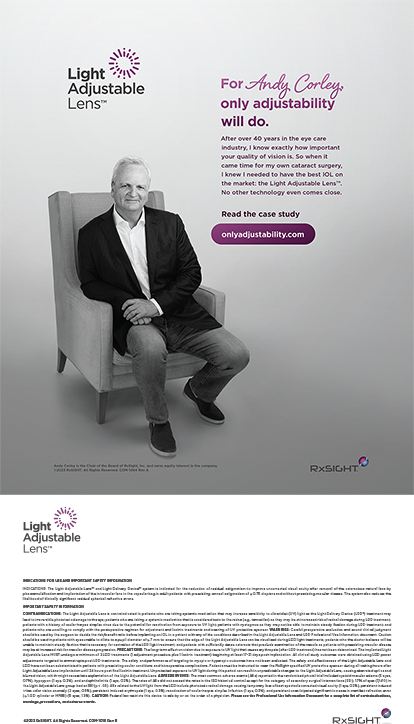
Comparison to expectations is an unavoidable part of the human experience. There is a classic story from the investment world of a conversation between a CEO and an intern discussing the company’s upcoming earnings data:
Intern: At what earnings level would you be suicidal?
CEO: One cent below the earnings forecasts.
Intern: At what earnings level would you be ecstatic?
CEO: One cent above the forecasts.
When it comes to the patient experience, quality always comes first. We never want to dress up junk. However, there are ways to educate patients toward appropriate expectations and help them appreciate the success of their outcomes. At every step of the patient journey, certain practices can help ensure that patients approach their experience with a healthy mindset.
KNOW YOUR PATIENT EXPERIENCE
The first step in appropriately delivering on expectations is knowing your patient experience. Go through what patients go through: Sit in your waiting room, hear how your technicians speak, go under your laser. I had my technicians dock the »VisuMax laser (Carl Zeiss Meditec) onto my eye and found that it was quite comfortable. But I also came to understand what my patients mean when they say they can’t see the green light until it is right in front of them. Understanding the patient experience by putting yourself in your patients’ shoes is invaluable. When their experience matches what you’ve told them to expect, you are meeting their expectations.
SET REALISTIC EXPECTATIONS
When educating patients about their treatment options, be sure to explain the full benefits of a procedure, but do not overpromise or say anything that would later undermine your informed consent or erode patient trust. We have great treatments to offer our patients, so be straightforward and set realistic expectations (see The Psychology of Choice Paralysis).
The Psychology of Choice Paralysis
LESSONS FROM PSYCHOLOGY
REDUCING CHOICE PARALYSIS
CONCLUSION
On evaluation day, ensure that your front-desk staff is providing every patient with superior service. Your patients should feel welcomed, and your practice environment warm. As the saying goes, “No one cares how much you know until they know how much you care.” Once the patient is physically in your practice, it should be all about him or her. A happy and interested staff reflects well on the doctor and sets the stage for trust, as any doctor who takes good care of staff must also truly care for his or her patients.
Conduct a thorough patient history, which should include collecting insights into the patient’s personality, for example with the Dell Questionnaire. When conversing with patients, your technicians should be picking up on comments that indicate expectations beyond what an intervention can provide. For example, many patients with cataracts arrive with complaints about both blurriness and scratchiness, the latter of which is not addressed by cataract surgery. Or a cataract patient may say, “I want cataract surgery because my vision is blurry and gets worse after watching TV for an hour.” This comment indicates that his or her dryness is visually significant after a while. Having technicians pick up on these expectation issues can be helpful, as many false expectations stem from incorrect understanding.
During the evaluation, I check the patient’s near and distance, monocular and binocular, and uncorrected and corrected vision. I check every combination of vision because it provides more data and helps equip us for the postoperative reveal. I stress always resetting the chart to the 20/400 line to minimize the likelihood of having a patient sitting in a room with letters he or she can’t see. Otherwise, there is a chance that the previous LASIK patient was happily seeing 20/10, but the next patient in the room is a postoperative day 1 cataract patient who thought her vision seemed great until she “couldn’t see the chart.” Don’t show patients a line they cannot read; this wastes time and doesn’t help anyone.
I also routinely use a range of diagnostic technologies. I particularly advise performing macular OCT and topography on every surgical patient. That does not mean you should bill for them all, but the knowledge is important. Patients will expect to be like their neighbor who saw 20/20 the day after surgery. If there is any reason why they may have a lower chance of that outcome, show it to them. If their topography shows irregular mires, show them theirs side by side with that of a normal eye. If they have irregular astigmatism with different axes on various topographies, show them why you have to make an educated guess on the toric alignment.
Last, put the information into a schematic, whether electronically or on paper, and explain: “The lens is in the middle. See that part? I’m going to remove the cataract right there. It will be nice and clear with your new lens. But remember, the light still goes through this cornea, which is irregular. Then, it will hit your retina, which still has the epiretinal membrane, and that will also impede that perfect vision. I think it will be a lot better and that you will be very happy, but remember, you will not see perfectly like your neighbor did.” The preoperative portion of the patient experience is education-intensive and can help set the stage nicely by establishing realistic expectations.
APPRECIATE SUCCESS
Technicians may want to run through the schedule and keep things rolling when they get to a day 1 postoperative patient, but do not let them rush. The first vision check is an important event. Start big at 20/400 and encourage blinking. Start binocular. Let patients see how happy they should be because, in general, our results are excellent and constantly improving.
As stated above, never show a patient a line that he or she cannot see. Look back at the preoperative corrected or uncorrected vision for comparison, and show the patient the additional lines he or she gained. Although there is far more to vision than Snellen acuity, many people like having an obvious comparison of before and after. Without the final 30 seconds of transformation photos comparing before and after, “Extreme Makeover: Home Edition” would never have been a successful television show.
Of course, we are not trying to play games here; we are simply trying to help patients appreciate their successful outcomes. When patients are unhappy, encourage them to identify what they can do, not what they cannot do—that is a key part of our learning about patients’ limitations.
If I anticipate needing to perform a LASIK or PRK touchup, I show the patient his or her vision at all distances to reeducate. Be liberal with LASIK and PRK touchups when clinically appropriate because quality results trump all else. With the FDA approval of the Light Adjustable Lens (»RxLAL, RxSight), postoperative fine-tuning for best results may become both easier and more routine.
CONCLUSION
Once we have delivered the best possible result we can to a patient, the only thing left is the comparison to his or her expectations. If these expectations have been set at a reasonable level through proper patient education, then the vast majority of our patients will be very happy. And that’s the best part of ophthalmology.




